

Haiku Deck Blog
Creative presentation ideas.
Show menu Hide menu
- Getting Started with Haiku Deck
- Haiku Deck Newsroom
- Presentation Resources for Events and Conferences
- Teaching with Haiku Deck
- Student Presentations
- Education Blogging with Haiku Deck
- Using Haiku Deck in the Classroom
- Using Haiku Deck for Professional Development Presentations
- Additional Presentation Resources for Teachers
Recent Posts
- Haiku Deck Classroom Partners with Google Education at ISTE
- Creative Ways Coaches Use Haiku Deck Presentations
- Brand and Leadership Coaching with Justin Foster
- Creating a coaching webinar with Haiku Deck
- Why webinars are the key to growing your coaching practice online
- August 2019
- August 2018
- February 2018
- January 2018
- November 2017
- October 2017
- September 2017
- August 2017
- October 2016
- September 2016
- August 2016
- December 2015
- October 2015
- September 2015
- February 2015
- January 2015
- December 2014
- November 2014
- October 2014
- September 2014
- August 2014
- February 2014
- January 2014
- December 2013
- November 2013
- October 2013
- September 2013
- August 2013
- February 2013
- January 2013
- December 2012
- November 2012
- October 2012
- September 2012
- August 2012
Six Simple Suggestions for Poetic Presentations
Poetic presentations.
Presentations are pervasive, perhaps unavoidable, in modern business culture. We depend upon them to document details and dictate discussion. We use them to inform and to teach.
But shouldn’t presentations also inspire? Can they be evocative as well as informational?
I believe they can, and I think a lot about the qualities that make presentations feel poetic rather than pedestrian.
Poetic Building Blocks
I’ll spare you the cliche of starting with the dictionary definition (see #2 below), but most descriptions touch on these essential components of poetry: the expression of feelings and ideas, distinctive style, rhythm, beauty, intensity of emotion, and brevity.
1. Expression
To me, the most important element of a poetic presentation is a single, powerful idea to build around, to expand upon, to infuse every aspect of your creation. Think of this as your creative hook or your angle. Without a strong underlying inspiration or theme, presentations can end up feeling rambling, jumbled, or disjointed — just a sequence of slides.
The Dragonfly Effect , an inspiring book and blog about how social media can drive social change, is a great example of how powerful a cohesive creative hook can be. I incorporated beautiful dragonfly imagery into this presentation I made to share the team’s unique approach.
Poetry in Practice : When you’re crafting a presentation, give yourself some time up front to identify a theme you can carry through. This could be a metaphorical idea, a powerful phrase, or some other unifying creative thread. I often get my ideas from exploring in the Haiku Deck image search .
2. Distinctive Style
There are a wide variety of unique poetic forms, each with its own mood, character, and general format. The same is true for presentations. Whether you are sharing a lighthearted list or making an impassioned case for a cause you care about, select a style that fits and carry it through cohesively. Each presentation you create should feel distinct, in a way that suits its unique purpose.
The other important point here is to be distinctive — which means taking special care to avoid cliche in subject matter, wording, and image choice.
I love how Mel Carson uses black & white portraits in this presentation promoting his book, Pioneers of Digital . The overall effect feels unified and perfectly tailored to its subject.
Poetry in Practice : Instead of templatizing your presentations, select fonts and images to reinforce your mood and theme. As you develop each presentation, keep formatting and even image palettes as cohesive as possible to sustain the mood.
Poetry is strongly associated with rhythm, with cadence, with well-chosen words. You can play with alliteration (the repetition of consonants), assonance (the repetition of vowel sounds), or even rhyme as you title your talk and script your slides.
Zooming out, try to give your presentation as a whole a sense of rhythm, structure, and flow. You can do this by repeating visual or text elements at regular intervals — for example, solid-color slides to introduce new sections, or a short, simple string of text repeated throughout for poetic emphasis.
“Sculpting an Elephant,” by Barry Casey, is a wonderful example of poetic language and rhythmic flow in practice:
Poetry in Practice : Allow yourself time, and a few edit passes, to explore possibilities for word choice — you might even use an online dictionary, thesaurus, or rhyming dictionary for ideas. If you land on a poetic, powerful phrase, try repeating it at intervals throughout your presentation to underscore its rhythmic resonance.
Beauty alone can’t carry an unsubstantial idea, but a beautifully presented idea can blossom into something bigger, more powerful. In a presentation, beauty may take the form of evocative, well-chosen images that deepen your meaning, or it could be an elegant metaphorical idea that intrigues and illuminates.
Take a look at how Brandon George uses clever images with a playful spin in this information-sharing presentation, “How to Get Ideas.” It’s a very creative take on beauty!
Poetry in Practice : Use high-quality imagery, and don’t rush the selection of your images — they should be more than just decoration. Be sure each image you choose deepens and extends your meaning or tells a story.
In the age of big data, it’s common to value information over emotion, and to structure presentations accordingly. Yet in the words of Jonathan Gottschall, author of The Storytelling Animal , “Humans simply aren’t moved to action by ‘data dumps,’ dense PowerPoint slides, or spreadsheets packed with figures. People are moved by emotion.”
“Humans simply aren’t moved to action by ‘data dumps,’ dense PowerPoint slides, or spreadsheets packed with figures. People are moved by emotion.” — Jonathan Gottschall
When we celebrated our company’s one-year anniversary last summer, I wanted to acknowledge the milestone with a mix of compelling stats and stories. Here’s how I wove the two together:
For another example, check out how a creative teacher infuses a basic scientific formula with storytelling in this educational presentation:
Poetry in Practice: No matter how data-heavy your presentation is, your message will be more memorable if you can turn your stats in stories. Emotion and information can work together to elevate your key points.
Certainly there are grand, epic forms of poetry, but most poetic forms favor brevity. Keeping your presentation concise and focused will nearly always make it feel more poetic.
This personality-packed presentation, created to cap off what was surely an epic Startup Weekend event, is an excellent example of how little text you actually need to get the point across.
Poetry in Practice: Instead of trying to pack in more — more words, more ideas, more thoughts, more data points — see what you can remove. Give your ideas some breathing room, so they can bloom.
Here’s one last example I’d like to share, in which I tried to incorporate all of these poetic building blocks to some extent. I created it for presentation expert Nolan Haims, based on a blog post he wrote that inspired me . (Sending this to him felt a bit like cooking dinner for a famous chef, and I offered to make any changes he requested, but he liked it !)
There’s no foolproof formula to creating poetic presentations — like poetry itself, there are plenty of forms to explore and ways to experiment. But I hope these poetic building blocks can plant some seeds for future presentation inspiration.
Do you have favorite examples or poetic presentations, or ideas to share? Let me know in the comments!
And if you appreciate what we’re doing, please cast your vote for poetic presentations in the Webby Awards — every vote makes a big difference!

Categories: inspiration
Tags: creativity , inspiration , presentation pointers , tips
© 2024 Haiku Deck Blog
Theme by Anders Norén — Up ↑

- Search Search Search …
Free Templates for Poetry for PowerPoint and Google Slides
Make your presentations and lessons stand out with these free templates for Poetry .
Download them to use with PowerPoint or edit them in Google Slides and start creating!
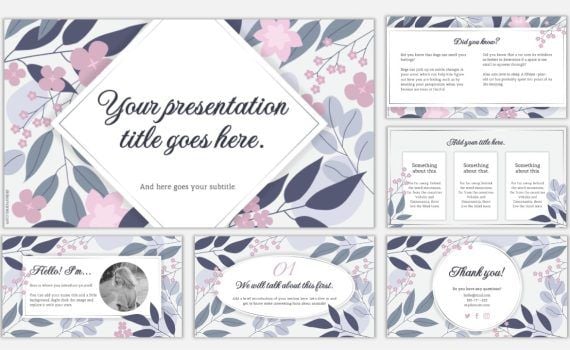
Elegant and classy with flowers and leaves backgrounds free PowerPoint Template and Google Slides Theme Amelia is a free PowerPoint and Google Slides template with elegant and classy floral backgrounds. It is perfect for a wedding slideshow or a poetry presentation. The template features a variety of flowers and leaves […]
Amelia free PowerPoint and Google Slides template with floral backgrounds.
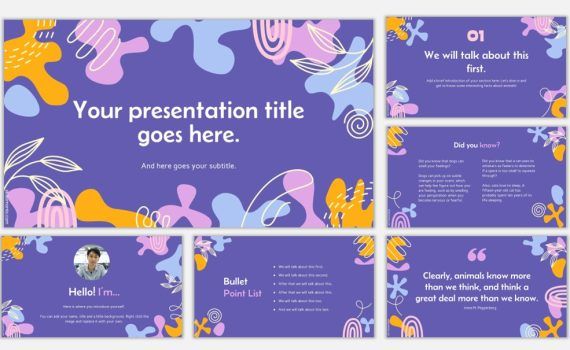
Cheerful colored wobbly shapes and lines free PowerPoint Template and Google Slides Theme If you need a cheerful template with abstract shapes, this theme is perfect for you. You can use it to talk about psychology, abstract thinking or even poetry. It comes with a certificate layout and I’ve used […]
Wobbly shapes and cheerful colors free slides theme.
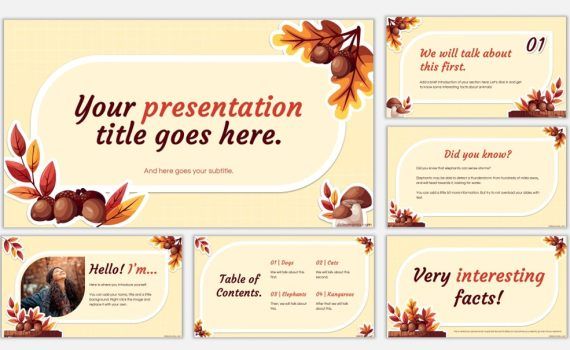
Autumn Stickers free Fall PowerPoint Template and Google Slides Theme This new autumn theme features fall leaves, acorns and mushrooms presented as digital stickers. Perfect for back to school or to present different outdoor activities to experience during fall. I’ve included a morning meeting / daily agenda slide and a […]
Autumn stickers, a fall theme for Google slides and ppt.
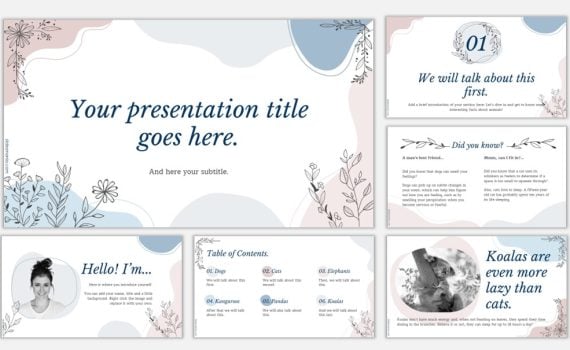
Beautiful and elegant free PowerPoint Template and Google Slides Theme Looking for a beautiful and elegant way to present your work? Look no further than this pastel floral Google Slides theme and PowerPoint template! With its soft colors and hand drawn flowers, this template is perfect for any occasion, from […]
Helena, poetry reading or classic book review free template.
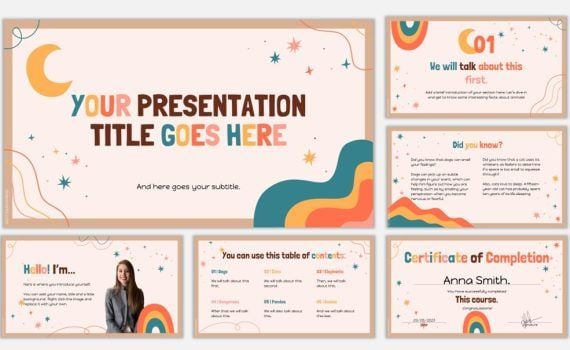
Free colorful Google Slides and PowerPoint template. Get ready to add some fun and color to your presentations with Maeve, it features hand-drawn shapes, stars, rainbows, abstract shapes and lines to make your presentations more engaging and professional. This template includes a morning meeting layout and a certificate template. Match […]
Maeve, joyful and creative slides theme.
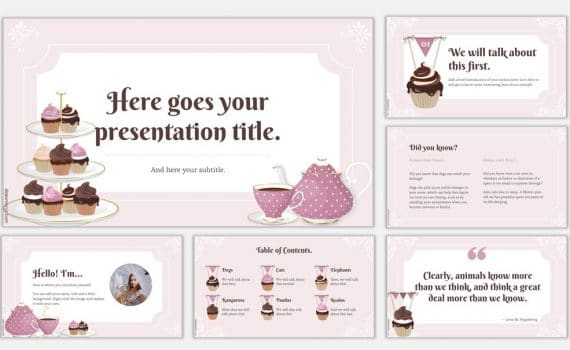
Free classy template for Google Slides and PowerPoint. The Finer Things Club template is perfect for a book club meeting, a baby shower, or a classy bachelorette party. It features tasty cupcakes with different frostings and tea, and it comes with a morning meeting layout. By editing the theme and […]
Cupcakes and tea, free presentation template.
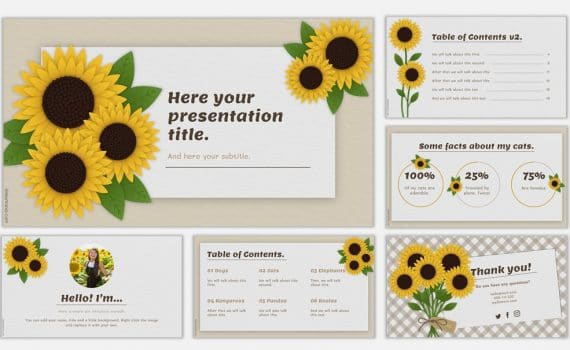
Cute sunflowers Template for PowerPoint and Google Slides Cute illustrated PowerPoint template and Google Slides theme with sunflowers. You can use it to talk about wellness, for example. It includes a morning meeting layout in case you want to use it in your classroom! DOWNLOAD POWERPOINT OPEN IN GOOGLE SLIDES
Cute sunflowers, Google Slides and ppt template.
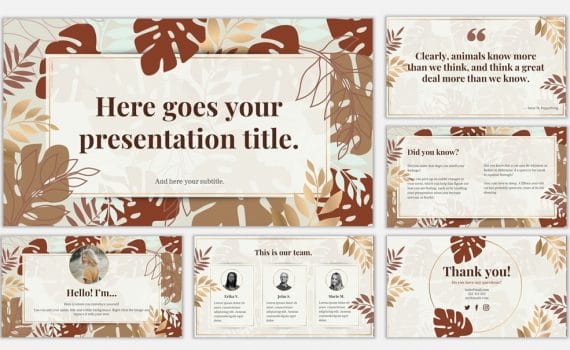
Gold and brown leaves. Free template for Google Slides and PowerPoint. Cassidy is a beautiful template with different brown shades and touches of gold. Perfect for a presentation about literature or art. Or to celebrate Fall. I’ve used theme colors, so if you wish to change its colors, follow this […]
Cassidy, brown and gold leaves. Beautiful illustrated slides.
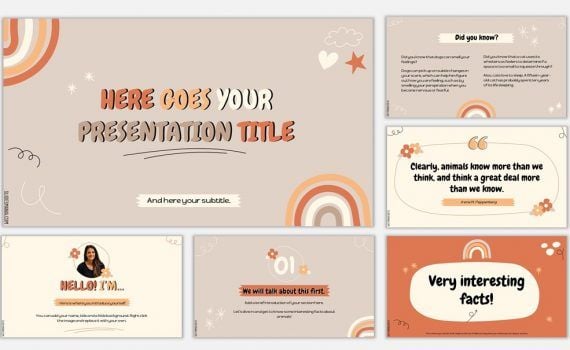
Free PowerPoint template and Google Slides theme. Free fun template with little doodles for PowerPoint and Google Slides presentations. Need some fun and laid back slides? Delaney has little doodles, neutral colors and even some gif animations. Little stars, arrows and flowers make a super cute presentation template. If you […]
Delaney, fun theme with neutral colors and doodles.
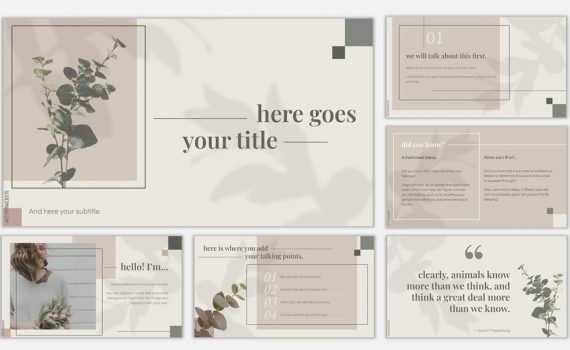
Free PowerPoint template and Google Slides theme. Template with a shadow overlay. Agnes is a beautiful inspirational slides theme. The shadow overlay gives it a unique touch and it can be easily adapted to different topics by simply changing the images of the plants, for pictures that represent your presentation […]
Agnes, elegant botanical theme.
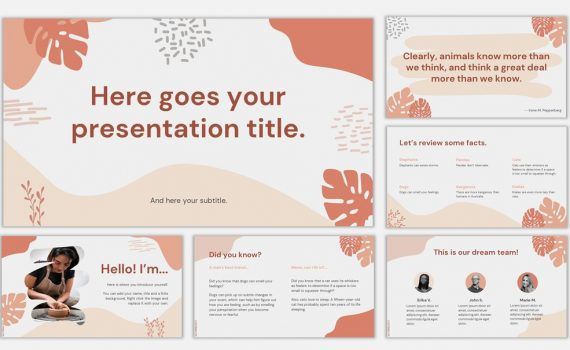
Free PowerPoint template and Google Slides theme. A simple and beautiful slides theme. Pastel presentation template. Rita is a simple presentation template and even though I’ve made it for pottery, it can be used for a number of different topics. I chose earthy pastel tones, but you can customize its […]
Rita, organic shapes free presentation template.
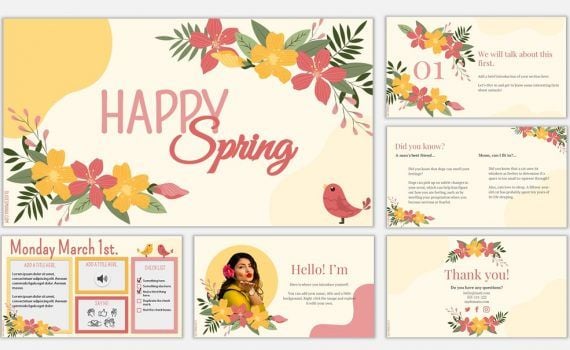
Free PowerPoint template and Google Slides theme. Flowers and birds presentation template. A new Happy Seasons template! Now it’s Spring’s turn! Many were asking for a Spring template to go along the Happy Seasons series, so here it is. It has hibiscus flowers and birds and it comes with a […]
Happy Spring, season slides and agenda.
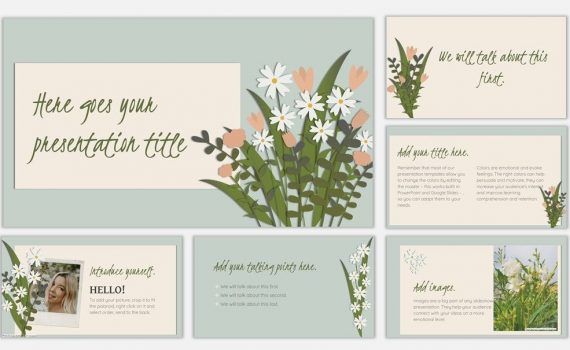
Free Spring Template for PowerPoint or Google Slides, Vivian. Vivian is a free Google Slides theme or pptx template inspired by spring. Little bouquets of wildflowers make this theme perfect to celebrate spring. By editing the master, you can change the colors of each type of flower. Vivian asked me for […]
Vivian Free Spring Template for Google Slides or PowerPoint presentations
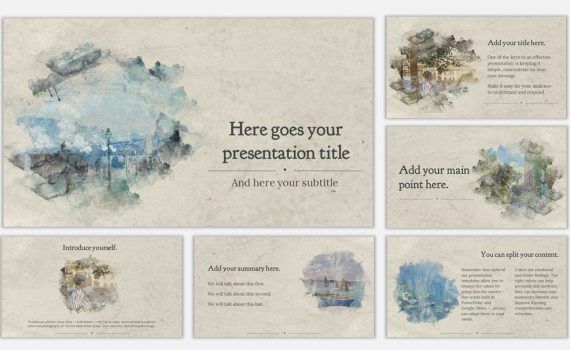
Free Template for PowerPoint and Google Slides Presentations Monet Monet free presentation template is, of course, perfect for presentations about art! Even though I chose Monet, you can use images from any other artist. I have found these images on the Art Institute of Chicago website. If you have time, I […]
Monet Free Template for Google Slides or PowerPoint Presentations

- My presentations
Auth with social network:
Download presentation
We think you have liked this presentation. If you wish to download it, please recommend it to your friends in any social system. Share buttons are a little bit lower. Thank you!
Presentation is loading. Please wait.
To view this video please enable JavaScript, and consider upgrading to a web browser that supports HTML5 video
What is Poetry? Characteristics of Poetry
Published by Nick Holding Modified over 9 years ago
Similar presentations

Presentation on theme: "What is Poetry? Characteristics of Poetry"— Presentation transcript:

Ms. Tripken’s English I EOC Terms.

Elements of Poetry.

Creative Writing Ms. Bilskemper

HOW TO EXPLICATE A POEM.

The Art of Poetry Poetry has been defined as “heightened language,” as it is generally a very artistic use of language, which puts the language into verse.

Characteristics, Analysis, Key Terms

TYPES OF POETRY. NARRATIVE POEMS A Narrative Poem combines elements of fiction and poetry to tell a story Like short stories, they usually include characters,

Day 65 – Intro to Poetry/Drama

Elements of Poetry English II Ms. Barrow.

Mirror by Sylvia Plath Who is the narrator of this poem?

Poetry Review. 0 The use of any elements of language more than once.

Poetry Handbook Definitions Alliteration The repetition of consonant sounds, usually at the beginnings of words or syllables. Example: over the cobbles.

“L to J” Literary Terms Part 2. Roll the dice… ABCDE FGHIJ KLMNO PQRST UVWXY.

Notes. 1. There are two types of poems: Narrative and lyric poems. Narrative poem- tells a story using plot, characters and setting and theme. Lyric.

Painting with Words Poetry. Form- the structure of the writing (what it looks like on the page)

Activator: February 23, 2009 In your own words explain what “poetry” is. What elements make a poem? Does a poem have a certain look, length, feel, purpose?

What is poetry? You tell me… Format Poetry is arranged in lines and stanzas Lines may or may not form a complete sentence Stanzas are a group of lines.

Poetry Terminology Identify the following definitions.

The Elements of Poetry. Introduction to Poetry Poetry is the most compact form of literature. A poem packs all kinds of ideas, feelings, and sounds into.

R EVISING FOR TEXTUAL ANALYSIS F OCUS ON THE KEY ASPECTS OF THE POEM THAT YOU WILL BE ASKED TO REFER TO IN YOUR ANSWER IN THE EXAM / NAB: Central concerns.
About project
© 2024 SlidePlayer.com Inc. All rights reserved.
Got any suggestions?
We want to hear from you! Send us a message and help improve Slidesgo
Top searches
Trending searches

26 templates

first day of school
69 templates

18 templates

48 templates

6 templates

great barrier reef
17 templates
Poetry Workshop
It seems that you like this template, poetry workshop presentation, premium google slides theme and powerpoint template.
Has there ever been a time when you felt like talking in rhyme? If you have your own poetry workshop and you want to make it to the top, then download this new template by Slidesgo—this design is great, we tell you so!
Let’s begin by saying that we wanted an elegant slide deck this time, so that’s why we’ve used a calligraphic font in the titles and the cover slide. First impressions are always the decisive ones, hence the inclusion of inspirational pictures. We’ve played around with a green color scheme, which feels peaceful and makes you enjoy a calm presentation. Backgrounds have some round shapes and layouts are very easy to edit. Get inspired by this template and customize it to your liking!
Features of this template
- An inspirational template with simple layouts and a green color palette
- 100% editable and easy to modify
- 20 different slides to impress your audience
- Available in six colors: light green, green, pink, red, yellow, and purple
- Contains easy-to-edit graphics and maps
- Includes 500+ icons and Flaticon’s extension for customizing your slides
- Designed to be used in Google Slides and Microsoft PowerPoint
- 16:9 widescreen format suitable for all types of screens
- Includes information about fonts, colors, and credits of the free and premium resources used
What are the benefits of having a Premium account?
What Premium plans do you have?
What can I do to have unlimited downloads?
Don’t want to attribute Slidesgo?
Gain access to over 25600 templates & presentations with premium from 1.67€/month.
Are you already Premium? Log in
Available colors
Original Color
Related posts on our blog

How to Add, Duplicate, Move, Delete or Hide Slides in Google Slides

How to Change Layouts in PowerPoint

How to Change the Slide Size in Google Slides
Related presentations.

Premium template
Unlock this template and gain unlimited access

Register for free and start editing online

Poetry Analysis
Jul 17, 2014
260 likes | 434 Views
Poetry Analysis. By Debi Rice. What We’re Looking For:. When we analyze a poem, there are three main categories to examine: Content Style Theme & Evaluation. Content. When we examine the content of a poem, we’re looking for things like: The reader’s first impressions
Share Presentation
- present day life
- what circumstances
- first impressions part
- word choice

Presentation Transcript
Poetry Analysis By Debi Rice
What We’re Looking For: • When we analyze a poem, there are three main categories to examine: • Content • Style • Theme & Evaluation
Content • When we examine the content of a poem, we’re looking for things like: • The reader’s first impressions • What the poem looks like on the surface • An examination of the poetic voice • The poem’s content • An examination of the poem’s title • Identification of conflicts within the poem • A discussion about tone & mood
Style • Looking at a poem’s style requires the reader to dig deeper than the surface and examine such elements as: • The type of poem we’re examining • The poem’s diction (word choice) • Identification & examination of figures of speech • Identification of images & symbolism • The parts of the poem appealing to the reader’s senses • The structure of the poem (if any)
Theme & Evaluation • In the final part of the analysis, the reader offers his/her ideas about the possible themes that are present in the poem. • Also, the reader communicates his/her final thoughts about the poem in general & the poems relationship to life.
Analyzing Content Digging Deeper
First Impressions • After reading the poem for the first time, it helps to record your first impressions. • Interesting words • Possible Subject • Your impressions will change as you re-read • You might begin by writing something like: • Upon first reading, a reader may get the impression Robert Frost is writing about walking in the woods on a nice day. He speaks of two roads…
On the Surface • This accompanies the first impressions part of the analysis. • This is where the reader tells the audience what the poem appears to be about literally before he/she looks at figures of speech & imagery.
Poet & Poetic Voice • Before offering any analysis, it is a good idea to find out about the poet who wrote the poem. • This requires a little research. • It is important to remember some poets don’t write as themselves. They adopt a persona (voice) to be the speaker. • Who is the AUDIENCE of the poem? • To whom is the speaker speaking?
Context • This is where learning about the poet comes in handy. • What circumstances existed to make this poet create this poem? • Details about the poet’s life • What’s happening in the world • Does the poet address a social, psychological, historical of mythical phenomenon?
Title • You must assume the poet chose the title deliberately. • How doe it fit? • Is it a good title to represent the poem? • How does it relate to the ideas in the poem? • Do you think it is an appropriate title? • Why do you think he/she decided on the title?
Conflicts • This may or may not be present in the poem, but it is often central to many poems. • Must be identified if present • Often poems with emotions themes are built around a conflict. • It is important to identify the conflict because it is conflict in the poet's life that probably inspired him/her to write the poem. • How do these conflicts help propel the poem?
Tone • Tone is the poet’s attitude towards his/her subject. • Tone is projected through poetic voice • It is created through diction (word choice), rhythm, rhyme & use of imagery. • It may be mournful, bitter, angry, reflective, melancholy, joyful, ironic, etc (an adjective) • By picking up tone of a poem, you will better be able to understand its intended meaning • When discussing tone, it is important for you to find examples of lines/diction in the poem which support your choice.
Mood: All About You • Mood is how the reader feels after reading the poem. It describes the atmosphere the poet creates. • How do you think the poet wanted you to feel? • Choice of words & imagery are what create mood. • Again mood is expressed as an adjective. • Again, find examples of lines/diction in the poem which explain how this mood is created.
Analyzing Style Digging Deeper
Type of Poem • Includes Form • Popular poetry forms include: • Lyric (short & musical; usually rhyme) • Sonnet (14 lines with definite rhyme) • Ballad (lyric poem which tells a story) • Ode (poem to praise something) • Epic (long, heroic poem) • Free Verse (no particular structure) • Elegy (like a eulogy only in poetic form)
Diction • This is the poet’s word choice • Upon reading a poem, be sure to discover the meanings of unfamiliar words & phrases, allusions, etc. • Is the poem free of cliches? • Are the words concrete or abstract? • How does the diction contribute or detract from the poem? * You must comment on diction & offer examples to support your claim in analysis.
Figures of Speech • The key to understanding & discussing poetry is in deciphering its figurative language. • Does the poet use figurative language? • Each must be identified then explained. • Tie them to the poem by telling what they mean both literally & figuratively
Imagery & Symbolism • Are there concrete images the poet wants the reader to see, hear, smell, touch, taste? • What images does the poem evoke? • How are they evoked? • How do the different images connect or contrast with one another? • Are there other aural (sound) and visual details?
Structure • Structure usually applies to poems that must follow a certain structure like sonnets, limericks, haiku, etc. • The way the lines are organized & grouped. • Rhyme, rhythm, & stanza division • Stanzas • Couplet (pair of lines that rhyme) • Triplet (3 lines that rhyme) • Quatrain (4 lines that rhyme) • Rhyme scheme • Rhythm (the existence of a regular beat How does the structure enhance/take away from the piece?
Analyzing theme & Evaluation Digging Deeper
Theme & Evaluation • Theme • Does the poem have an underlying message? • Does the poem try to tell us something about life or humanity? • Is the poem trying to teach a lesson? • Evaluation • Is an experience intensely felt by the reader? • Does the poem succeed in sharpening the reader’s awareness of something significant?
Theme & Evaluation • In the final part of analysis, the reader offers his/her final thoughts about the poem in general. • An educated guess about the poem’s theme • The reader’s judgment about the poem • Whether the poet achieved his/her purpose • Discussion of how the poem's theme relates to present day life and/or experiences • Of the reader • Of society in general
- More by User
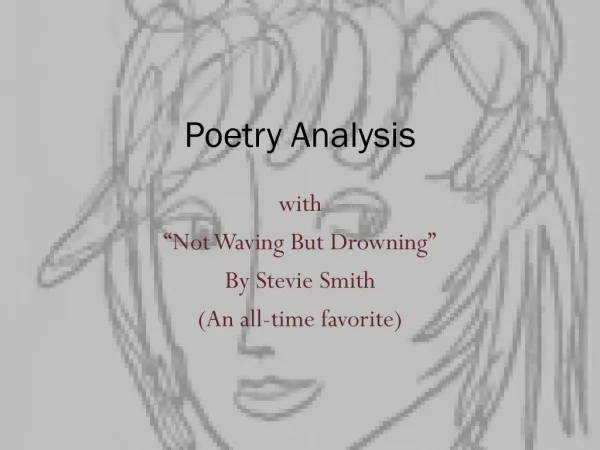
Poetry Analysis. with “Not Waving But Drowning” By Stevie Smith (An all-time favorite). Not Waving But Drowning: Read. Suggestions. The Poem. Nobody heard him, the dead man, But still he lay moaning: I was much further out than you thought And not waving but drowning.
586 views • 10 slides

Poetry Analysis. Mrs. Belof. Poetry Analysis Using the TP-CASTT Method. What is TP CASTT? . An acronym of steps used to analyze poetry. The results of TPCASTT can be used to write an essay. The TPCASTT process is comprised of 7 steps which should be completed in the order given.
869 views • 59 slides

Poetry Analysis. By: X avier Johnson Class: English9. “They will never break me” (Bullying) By: Lamont Carey https:// www.youtube.com/watch?v=PV5I9QS9UhMb. Spoken word poem . Lamont C ary .
293 views • 15 slides

Poetry Analysis. with “Not Waving But Drowning” By Stevie Smith (An all-time favorite). Not Waving But Drowning: Read . Suggestions. The Poem. Nobody heard him, the dead man, But still he lay moaning: I was much further out than you thought And not waving but drowning.
648 views • 10 slides

Poetry Analysis. Resurrection F.R. Scott . Resurrection.
213 views • 5 slides

Poetry Analysis. How to Scansion. Meter and Feet. Rhythm. Iamb – unstressed , stressed Trochee – stressed, unstressed Anapest – unstressed, unstressed, stressed Dactyl – stressed, unstressed, unstressed Amphibrach – unstressed, stressed, unstressed. Steps to Scansion.
233 views • 7 slides
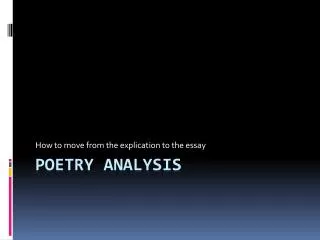
How to move from the explication to the essay. Poetry Analysis . Opening Paragraph. The first paragraph The first paragraph should present the large issues; it should inform the reader which conflicts are dramatized and should describe the dramatic situation of the speaker.
241 views • 10 slides

Poetry Analysis. One way out of a million… . What’s it all about?. THEME What is the Big Issue of life that the author is addressing? What is his or her specific statement about this issue? To find the theme, dissect the fiction and/or poetic elements the author uses… .
349 views • 16 slides

Poetry Analysis. Jasmine Thornton L. Johnson April 29, 2013. Introduction. Title: Naming of Parts
481 views • 10 slides

Poetry analysis
Poetry analysis. SPOT THE DIFFERENCE. There are 15 differences to spot in this picture, the person to do it in the fastest time is the winner!. Similarities . It’s always easier to spot differences, but it isn’t always as easy to spot the similarities.
266 views • 11 slides
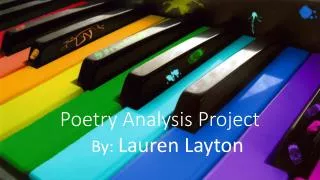
Poetry Analysis Project
Poetry Analysis Project . By: Lauren Layton . Spoken Word Poetry: What is it?.
347 views • 17 slides

Poetry Analysis. Using TPCASTT as a Method for Poetic Analysis. What is TPCASTT?. TPCASTT is an acronym to help you when analyzing poetry. Just like with SIFTT and SOAPSTone , TPCASTT will help you remember to what you should pay close attention when reading poetry. TPCASTT stands for T itle
683 views • 17 slides

Poetry Analysis 101
Poetry Analysis 101. Where do I start?. To really understand a poem you need to read it 3 times. 1 st to just read it through 2 nd to analyze structure (rhyme scheme, meter, figurative language, etc.) 3 rd to analyze meaning Let’s start with an easy one. Music by Percy Bysshe Shelly.
377 views • 21 slides

Poetry Analysis. The Death of the Ball Turret Gunner. by Randall Jarrell From my mother's sleep I fell into the State, And I hunched in its belly till my wet fur froze. Six miles from earth, loosed from its dream of life, I woke to black flak and the nightmare fighters.
377 views • 15 slides
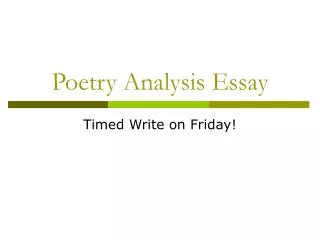
Poetry Analysis Essay
Poetry Analysis Essay. Timed Write on Friday!. What does it mean to “analyze” a poem?. We are trying to figure out what the theme of the poem is… AND
1.18k views • 19 slides

Poetry Analysis. Refugee in America. Journal. What does freedom mean to me?. Review. Review these poetic elements and devices with your shoulder partner: Speaker / Narrator Stanza Rhyme scheme Figurative Language (simile, metaphor, personification) Alliteration Sensory Language
274 views • 16 slides
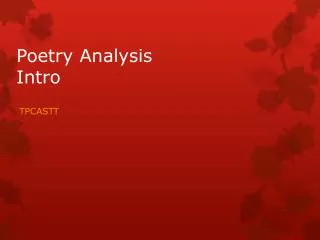
Poetry Analysis Intro
Poetry Analysis Intro. TPCASTT. Introduction to Poetry Billy Collins. I ask them to take a poem and hold it up to the light like a color slide or press an ear against its hive. I say drop a mouse into a poem and watch him probe his way out,
360 views • 12 slides

Poetry Analysis. Shakespearean Sonnet. Rhyme Scheme. My mistress' eyes are nothing like the sun William Shakespeare My mistress' eyes are nothing like the sun; Coral is far more red than her lips' red: If snow be white, why then her breasts are dun;
276 views • 15 slides

Poetry Analysis. Word Choices. Football by Louise Jenkins. How does the word choice of the poet of Football help you visualize what he is saying? How do you make do with what you have? What types of choices do you have to make?. Cat Scat by Eamon Grennan. Identify two similes.
69 views • 5 slides

Poetry Analysis. TPFASTT. Getting Started…. This is a process to help you organize your analysis of poetry. Together, we are going to analyze “Still I Rise” using T-PFASTT. Add your analysis of “Still I Rise” to this sheet!. T is for TITLE. Analyze the title first.
247 views • 18 slides

Poetry Analysis. Outcomes. In this lesson you will learn: How to read a poem Tips on how to effectively analyze a poem Poetic Techniques. Poetry – “Yuck????”. Students are often apprehensive about the study of poetry. Poetry does not need to be a difficult task.
256 views • 23 slides

Poetry Analysis Essay. What does it mean to “analyze” a poem?. We are trying to figure out what the theme of the poem is… AND How the poet uses literary devices (figurative language, imagery, repetition, symbolism, etc) to make their point about the theme in the poem. First things first!.
237 views • 19 slides

IMAGES
VIDEO
COMMENTS
Look for lines that are longer or shorter than most other lines. Line Length. A gentle rain bathes the windshield—. Back and forth the wiper blades mark the minutes. with their steady, hypnotic rhythm. Whispers and giggles and squeals of delight. fill every empty space in the backseat.
Poetry. Step into the world of poetry with this creatively designed Google Slides and PowerPoint template! Made in collaboration with teachers, this layout features a playful and engaging way to teach elementary school students about the beauty of poetry. With its notebook-style presentation and thematic illustrations, it's sure to grab their...
Introduction to poetry. Mar 6, 2014 • Download as PPTX, PDF •. 71 likes • 109,205 views. Lebogang Mosimango. Education. 1 of 25. Download now. Introduction to poetry - Download as a PDF or view online for free.
Lifestyle Education. 1 of 39. Poetry PowerPoint - Download as a PDF or view online for free.
Step into the world of poetry with this creatively designed Google Slides and PowerPoint template! Made in collaboration with teachers, this layout features a playful and engaging way to teach elementary school students about the beauty of poetry. With its notebook-style presentation and thematic illustrations, it's sure to grab their attention ...
Sculpting An Elephant - Created with Haiku Deck, presentation software that inspires. Poetry in Practice: Allow yourself time, and a few edit passes, to explore possibilities for word choice — you might even use an online dictionary, thesaurus, or rhyming dictionary for ideas.If you land on a poetic, powerful phrase, try repeating it at intervals throughout your presentation to underscore ...
Poetry is an extremely broad genre of imaginative writing. As teachers, it is sometimes difficult to know where to begin! This PowerPoint presentation has been designed to introduce your students to eight of the most popular and well-known forms of poetry. It provides an overview of the purpose, structure and rhyming pattern of the following ...
Free Google Slides theme, PowerPoint template, and Canva presentation template. World Poetry Day is celebrated on March 21, supporting the importance and relevance of this kind of literary expression. To help you with your presentation for this date, we've created this template. Be yourself and edit these minimalist slides—add exactly what ...
Jan 12, 2017 • Download as PPTX, PDF •. 72 likes • 70,392 views. R. Rabiatul Hamidah. An Assignment of Extensive Reading Class: PPT of Poetry. Education. Download now. Definition, elements, types, and genres of poetry - Download as a PDF or view online for free.
Make your presentations and lessons stand out with these free templates for Poetry. Download them to use with PowerPoint or edit them in Google Slides and start creating! Elegant and classy with flowers and leaves backgrounds free PowerPoint Template and Google Slides Theme Amelia is a free PowerPoint and Google Slides template with elegant and ...
830 likes | 1.78k Views. Introduction to Poetry. Poetry!. For the poetry part of this standard, you need to identify and respond to the: subject matter, language, and sound devices in a variety of poems. Poetry!. As you read a poem, you may "hear" the writing in your mind. Download Presentation. traditional verse.
Presentation Transcript. Elements of Poetry Poets have many tools they use to add to the poem's sound, meaning, and emotional effect on the reader. Poetry is the art of expressing one's thoughts in verse. • It uses few words to convey its message. • It is meant to be read aloud.
Use this presentation to teach your students about the different elements of poetry. The presentation describes each element and gives an example for the students to study. The PowerPoint offers built-in check-for-understanding slides, making it easy to see which students need extra support while keeping your students engaged throughout the ...
1- Poetry uses concentrated language: less words, more meaning. 2- All words are chosen carefully so that each word packs a punch. 3- Words are chosen for their sound and layers of meaning. 4- Often poetry uses language in a beautiful, creative, and expressive way. 6 6- Words are intentionally arranged in separate lines.
This PowerPoint presentation has been designed to introduce your students to five commonly used elements of poetry. It provides an overview and example of the following poetic elements: structure and form. rhythm. rhyme. sound devices. figurative language. A PDF version of the PowerPoint is also available.
2. Poetry: Poetry is a form of writing that uses not only words, But also form, Patterns of sound, Imagery, And figurative language To convey the message. Any Poem will include some or all of these elements. 3. 1. FORM: A poem's form is its appearance. Poems are divided into lines. Many poems, especially longer ones, may also be divided into ...
These elements include: • Rhythm • Sound • Imagery • Form. Rhythm • Rhythm is the flow of the beat in a poem. • Gives poetry a musical feel. • Can be fast or slow, depending on mood and subject of poem. • You can measure rhythm in meter, bycounting the beats in each line. • (See next two slides for examples.)
Premium Google Slides theme, PowerPoint template, and Canva presentation template. This presentation is an amazing creation. It was designed by Slidesgo's team, and it's full of resources and dreams! If you want to further develop your skills as a poet, great, do it with this poetry workshop template! Expressing your creativity and that of ...
If you have your own poetry workshop and you want to make it to the top, then download this new template by Slidesgo—this design is great, we tell you so! Let's begin by saying that we wanted an elegant slide deck this time, so that's why we've used a calligraphic font in the titles and the cover slide. First impressions are always the ...
Introduction to Poetry: Grades 9 & 10. This lesson introduces students to the analysis of poetry by examining various poetic devices and terminology. Students will learn to identify and analyze rhyme, rhythm, sound, and figurative language in order to gain a deeper understanding and appreciation of poetry. Through interactive activities and ...
The presentation will be launched by poet and lawyer Dean Kalimniou and will conclude with live Cretan music and refreshments. When: Sunday June 9, 2.30pm Where: Greek Community of Melbourne, 168 ...
Poetry ppt. This document discusses various elements of poetry, including how poets carefully choose words to express ideas through rhythm, sound, and imagery. It describes common poetic devices like rhyme, repetition, alliteration, and onomatopoeia that add musicality and vivid descriptions. Figurative language such as similes, metaphors, and ...
Gr. 12 Poetry Presentation (Formal Speaking & Listening Assessment) Value: 16 points Project description: in groups of two or three you will select a poem and share your thoughts on it with the class. Project details: You will select a poem and present that poem to the class. The poem must employ at least 4 figures of speech or poetic devices and require interpretation to some degree.
Presentation Transcript. Elements of Poetry: An Introduction for 4th Grade Connections. Lines and Stanzas Lines Stanzas • Single lines in a poem. • Several lines are organized into stanzas. 2 lines = Couplet 3 lines = Tercet 4 lines = Quatrain 5 lines = Cinquain 6 lines = Sestet 8 lines = Octet • Stanzas usually express a unique idea ...
This week in Year 1 we enjoyed a presentation from Mr. Brown about African animals. We learned so much about many African animals including different types of antelopes, big cats, elephants, buffalo and snakes. We were fascinated to hear about the fearless honey badger. Thank You Mr. Brown! The Year 1 Team.
Presentation Transcript. Poetry Analysis By Debi Rice. What We're Looking For: • When we analyze a poem, there are three main categories to examine: • Content • Style • Theme & Evaluation. Content • When we examine the content of a poem, we're looking for things like: • The reader's first impressions • What the poem looks ...